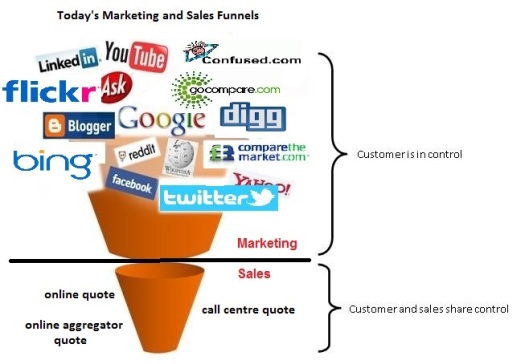Today’s competitive advantage front line is at the ‘marketing’ and ‘sales’ pipelines, or more correctly, ‘funnels’. In the ‘not so old’ days, there was one ‘sales pipeline’ and almost everything about this was the business of the sales team.
As companies grew larger, they broadened the pipeline so that multiple sales channels could use it, e.g. direct sales, indirect sales, B2B, B2C, etc. Marketing was disruptive and marketers vied for the attention of the potential buyers, e.g. they disrupted our TV viewing with TV ads, disrupted our reading with magazine ads and even disrupted out web browsing with irritating pop-up ads. Nowadays things are very different, or so marketers will tell you.
With the ‘not so old’ marketing techniques, companies tried to reach a broad audience in the hope that a small percentage (usually 1-3%) would respond. Looking at this another way, 97% of the marketing effort (and budget) was wasted!
The ‘not so old’ marketing methods included:
- Internal sales (account management)
- Telemarketing
- Tradeshows
- Seminars
- TV and Print Advertising
- Direct mail/email
In today’s terms this funnel has become very complex and the marketers are no longer in control.
Nowadays, simply having a website is longer enough – it is all about being in the ‘Top 5’ of a Google search results page (SERP). If your company is not in the ‘Top 5’ of the organic search, you have to pay for an advert and even this is not a guarantee of success since it is now generally accepted that most people (72%) ignore Google ads.
There is a plethora of research papers, marketing theories and information on ‘how to improve your Google SERP results but how many people are looking at what happens when they get there, i.e. when they (the potential customers) actually go to get a quote?
- What percentage of sales prospects ‘drop off’ between beginning of a quote and obtaining a quote?
- What percentage of sales prospects ‘drop off’ between obtaining a quote and policy inception?
- What percentage of sales prospects ‘drop off’ at each stage of the ‘end to end’ quote process?
- What step causes most ‘drop off’?
- What stage (rating question) of each step causes them to ‘drop off’?
- How many people save their quote and return to finish it?
- How many people save their quote and return to re-work it?
- What percentage of people that call have already got a quote online?
- What percentage of people that call have already got a ‘partial’ quote online?
These are questions that products such as IBM’s TeaLeaf can go some way towards answering but, once ‘insights’ are discovered, what can companies do to improve their performance?
- The major ‘progress blocker’ is the speed of change request (CR) delivery
- External ‘quotation engine’ suppliers are notoriously slow in delivering change
- Internal system developers are often weighed down with ‘compliance’ and BAU issues
- With multiple ‘live’ sales channels, the required change delivery process is often considered to be highly complex, high risk and high cost
With the amount of quantitative and qualitative data available, competitive advantage is difficult to sustain. Competitive advantage, it seems, is a fleeting moment of abnormal success.
- External consultants learn from one client and eventually pass on the knowledge and techniques to their next client.
- IT developers also learn from one employer and quickly turn what they learn into a package that they tout around the marketplace.
- Employees change employer and do likewise – even though success in one place doesn’t always equal success in another.
In short, competitive advantage from a digital marketing viewpoint can only sustained through constant experimentation, A/B testing and iteration, i.e. innovation.
The problem nowadays is one of time, which equals money. It is often the case that IT development cannot take place at a pace that suits constant experimentation, constant A/B testing and constant iterations, e.g. A/B testing of SEO iterations can now be done in 3-4 days.
- Some systems (and some IT departments) simply cannot deliver change in this time frame.
For this reason, the responsibility for some corporate websites is being taken away from IT and taken over by the Marketing department. This allows constant, iterative change to the website in terms of SEO, Content Marketing and Social Media Marketing – the combination of all three = Inbound Marketing.
With the success of Inbound Marketing, the blockage (or wastage) has now moved down into the sales funnel, i.e. the quotation system.
How long will it be before the sales quotation engines are moved across to Marketing?
The first to do this will gain significant competitive advantage … for a while



